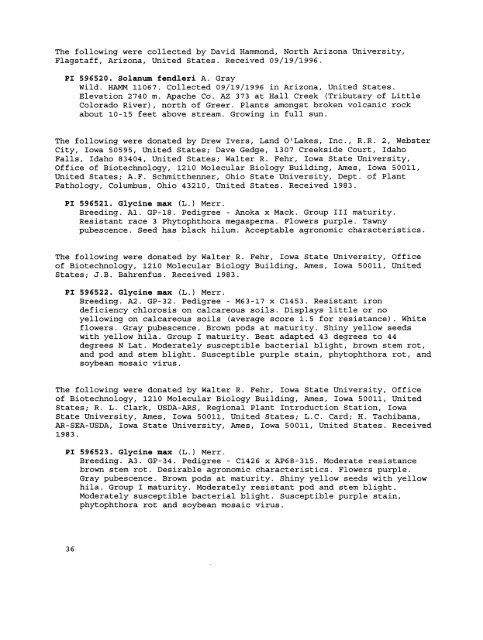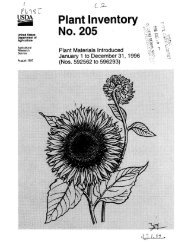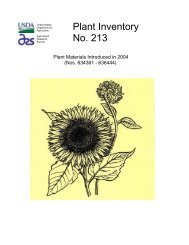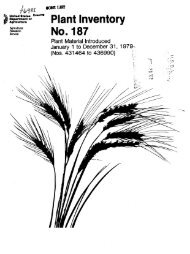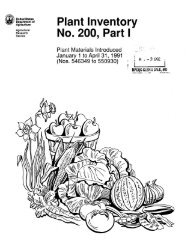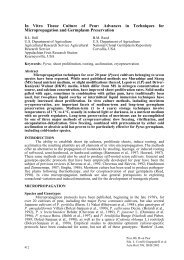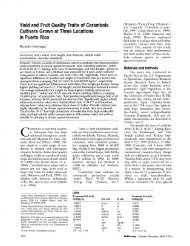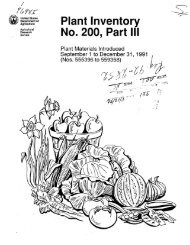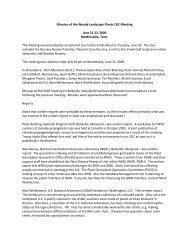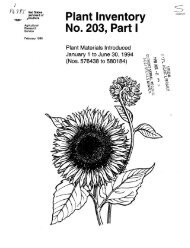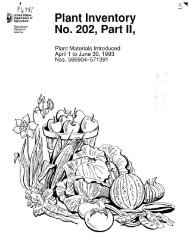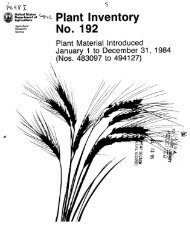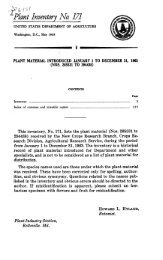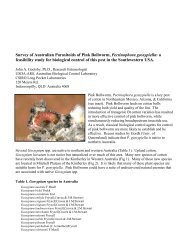- Page 1 and 2: USDA United States Department of Ag
- Page 3 and 4: Norris, R.A., ed. 1998. Plant Inven
- Page 5 and 6: The following were developed by Fer
- Page 7 and 8: 01/07/1997. PI 596311. Zea mays L.
- Page 9 and 10: Cultivar. "ASG06". PVP 9700048. The
- Page 11 and 12: The following were developed by Jul
- Page 13 and 14: with maize chlorotic mottle virus.
- Page 15 and 16: Breeding. WCL-LY1. GP-20. Pedigree
- Page 17 and 18: Seeds can be ground for meal or flo
- Page 19 and 20: Uncertain. HO-17; Ames 15664. The f
- Page 21 and 22: The following were donated by Karl
- Page 23 and 24: The following were developed by Har
- Page 25 and 26: and Development Ctr., Wooster, Ohio
- Page 27 and 28: miles east of Junction US 170/70 on
- Page 29 and 30: 9 milesnorth of Salt Flat. PI 59644
- Page 31 and 32: 2 903, 13.6 miles south of 1-20 (at
- Page 33 and 34: PI 596480. Plantago ovata Forssk. W
- Page 35 and 36: Breeding. Inbred. "0C19"; Ames 2006
- Page 37: PI 596515. Arachis hypogaea L. Bree
- Page 41 and 42: hardiness zone 3. Growing season in
- Page 43 and 44: Breeding. Camp-lx2. GP-184. Pedigre
- Page 45 and 46: States. Received 01/07/1997. PI 596
- Page 47 and 48: The following were developed by DeK
- Page 49 and 50: Cultivar. "PM 1560 BG/RR". PVP 9700
- Page 51 and 52: Genetic. Pureline. V. 967416; NEAR
- Page 53 and 54: PI 596627. Zea mays L. ssp. mays Br
- Page 55 and 56: indicates dehiscent anthers and mal
- Page 57 and 58: netting. Small globular fruit, leng
- Page 59 and 60: west. Savanna biome, arid sweet bus
- Page 61 and 62: Wild. 57. Collected 05/01/1996 in S
- Page 63 and 64: diameter 70 mm. Flesh green, seed w
- Page 65 and 66: Cultivar. "DOLCEA". PVP 7200134. PI
- Page 67 and 68: PI 596714. Phalaris canariensis L.
- Page 69 and 70: PI 596727. Cuphea glutinosa Cham. &
- Page 71 and 72: Wild. RWCF 37; Ames 21538. Collecte
- Page 73 and 74: The following were developed by Mar
- Page 75 and 76: 03/25/1997. PI 596759. Medicago sat
- Page 77 and 78: Cultivar. "3INI2". PVP 9700163. PI
- Page 79 and 80: The following were donated by Fleet
- Page 81 and 82: PI 596825. Oryza sativa L. Cultivar
- Page 83 and 84: Cultivar. "IDIAP-863 11 ; BE-4616;
- Page 85 and 86: heading. 109 cm plant height. 3 pac
- Page 87 and 88: PI 596884. Oryza sativa L. Breeding
- Page 89 and 90:
38409-1/38941-1//P4278-F2-80-4-1X.
- Page 91 and 92:
Breeding. IR53915-137-3-2-3; BE-487
- Page 93 and 94:
PI 596946. Oryza sativa L. Breeding
- Page 95 and 96:
PI 596965. Oryza sativa L. Breeding
- Page 97 and 98:
Ching Shi 15/Ta Mao Tao. 75 days to
- Page 99 and 100:
The following were developed by Yeo
- Page 101 and 102:
933, Manila, Luzon 1099, Philippine
- Page 103 and 104:
PI 597041. Oryza sativa L. Breeding
- Page 105 and 106:
Breeding. IRBB1 (XA-1); BE-7120; Q
- Page 107 and 108:
PI 597091. Oryza sativa L. Breeding
- Page 109 and 110:
Exp. Station, Department of Horticu
- Page 111 and 112:
The following were donated by Bruce
- Page 113 and 114:
PI 597122. Vitis hybrid Cult ivar.
- Page 115 and 116:
PI 597155. Vitis hybrid Cultivar. P
- Page 117 and 118:
Cultivar. SEIBEL 15062. Collected i
- Page 119 and 120:
PI 597222. Vitis hybrid Cultivar. E
- Page 121 and 122:
The following were donated by Rober
- Page 123 and 124:
The following were donated by Byron
- Page 125 and 126:
PI 597301. Vitis hybrid ILL 271-1.
- Page 127 and 128:
Cultivar. "PH09B". PVP 9700218. PI
- Page 129 and 130:
The following were developed by Ang
- Page 131 and 132:
Seedling emergence moderate-good, e
- Page 133 and 134:
PI 597368. Helianthus annuus L. Bre
- Page 135 and 136:
Asgrow A3733. Indeterminate, late G
- Page 137 and 138:
noninfested SCN locations, was 2% h
- Page 139 and 140:
Cultivated. Pureline. Hefen 22; SY
- Page 141 and 142:
The following were donated by R.L.
- Page 143 and 144:
PI 597463. Glycine max (L.) Merr. C
- Page 145 and 146:
University of North Wales, Bangor,
- Page 147 and 148:
Station, 200. Lane 361. Sect. 1. Ch
- Page 149 and 150:
The following were donated by Richa
- Page 151 and 152:
Elevation 84 0 m. Mountainside west
- Page 153 and 154:
deg. 15' N. Longitude 27 deg. 10' E
- Page 155 and 156:
PI 597568. Trifolium hybridum L. Wi
- Page 157 and 158:
PI 597580. Antirrhinum barrelieri B
- Page 159 and 160:
National Research Council, Ottawa,
- Page 161 and 162:
PI 597606. Gypsophila oldhamiana Mi
- Page 163 and 164:
Wild. RJL 017; 92-377; NA 66951; Am
- Page 165 and 166:
The following were donated by Karl
- Page 167 and 168:
Agricultural Research Ctr., Bldg. 0
- Page 169 and 170:
The following were donated by Reid
- Page 171 and 172:
PI 597671. Solanum coloxnbianum Dun
- Page 173 and 174:
Bolivia. Latitude 18 deg. 23' S. Lo
- Page 175 and 176:
purple, stellate, fruits round to r
- Page 177 and 178:
fruits round, maturing to mature. P
- Page 179 and 180:
Bolivia. Latitude 19 deg. 7' S. Lon
- Page 181 and 182:
km marker 143. growing along roadsi
- Page 183 and 184:
near km marker 143. growing in gras
- Page 185 and 186:
m. Oropeza: at km 25 marker N of Su
- Page 187 and 188:
Russian wheat aphid (RWA), Diuraphi
- Page 189 and 190:
Cultivar. "UTE". PVP 9700283. The f
- Page 191 and 192:
PI 597820. Brassica barrelieri (L.)
- Page 193 and 194:
PI 597848. Erysimum cuspidatum (M.
- Page 195 and 196:
PI 597869. Trifolium beckwithii W.
- Page 197 and 198:
The following were developed by Del
- Page 199 and 200:
PI 597899. Helianthus annuus L. Wil
- Page 201 and 202:
PI 597913. Helianthus hybrid Wild.
- Page 203 and 204:
States. Alice. The following were d
- Page 205 and 206:
normal (9+1) di-adelphous condition
- Page 207 and 208:
6733 selected from the World Sorghu
- Page 209 and 210:
Sorghum Collection. Early maturing,
- Page 211 and 212:
ARS, Iowa State University, Departm
- Page 213 and 214:
PI 597997. Glycine max (L.) Merr. G
- Page 215 and 216:
identify segregation of the ms6 all
- Page 217 and 218:
PI 598028. Glycine max (L.) Merr. G
- Page 219 and 220:
Genetic. Pureline. A96-965-3. GP-24
- Page 221 and 222:
PI 598064, Glycine max (L.) Merr. C
- Page 223 and 224:
percentage. Multigerm diploid segre
- Page 225 and 226:
PI 598087. Sorghum bicolor (L.) Moe
- Page 227 and 228:
The following were developed by Den
- Page 229 and 230:
; L.J. Reddy, Int. Crops Res. Inst.
- Page 231 and 232:
The following were donated by Jerry
- Page 233 and 234:
The following were donated by Jerry
- Page 235 and 236:
PI 598199. Linum usitatissimum L. C
- Page 237 and 238:
United States. Received 07/17/1997.
- Page 239 and 240:
Research, USDA, ARS, 6883 South Hwy
- Page 241 and 242:
Breeding. WEBSTER 2530. Collected 1
- Page 243 and 244:
PI 598273. Phaseolus vulgaris L. W6
- Page 245 and 246:
Abashiri District, Hokkaido Prefect
- Page 247 and 248:
PI 598316. Triticum aestivuxn L., n
- Page 249 and 250:
Cultivated. UCR 4538; MUTANT BAMBEY
- Page 251 and 252:
ackcrosses of an existing Rondo pea
- Page 253 and 254:
Corson County. LD: NWNW36 18W 25E.
- Page 255 and 256:
grasses and radishes. PI 598401. Da
- Page 257 and 258:
N. Longitude 8 deg. 16' W. Elevatio
- Page 259 and 260:
PI 598453. Lolium perenne L. Wild.
- Page 261 and 262:
Primorye Kray, RSFSR. Siberia. Agaf
- Page 263 and 264:
PI 598486. Elymus aristiglumis (Ken
- Page 265 and 266:
PI 598507. Festuca rubra L. Cultiva
- Page 267 and 268:
southwest of Dafeng, Xinjiang. PI 5
- Page 269 and 270:
Drainage ditch along road to Salimu
- Page 271 and 272:
PI 598563. Poa pratensis ssp. angus
- Page 273 and 274:
vegetation Bromus inermis, Leymus a
- Page 275 and 276:
Kazakhstan. Latitude 4 9 deg. 14•
- Page 277 and 278:
PI 598611. Psathyrostachys juncea (
- Page 279 and 280:
Agropyron desertorum, A. cristatum,
- Page 281 and 282:
Wild. JA-20; VIR U-0134851; W6 1329
- Page 283 and 284:
Wild. JA-37; VIR U-0134760; W6 1331
- Page 285 and 286:
Shagan Valley, upper edge of melted
- Page 287 and 288:
Wild. JA-73; VIR U-0134839; W6 1334
- Page 289 and 290:
fragile, Kochia prostrata, Artemisi
- Page 291 and 292:
PI 598722. Bromus setifolius J. Pre
- Page 293 and 294:
The following were collected by Kay
- Page 295 and 296:
150mm. Dominated by Artemisia terra
- Page 297 and 298:
Chita Region, Siberia. PI 598766. E
- Page 299 and 300:
University, Logan, Utah 84322-6300,
- Page 301 and 302:
PI 598812. Elyxnus wawawaiensis ine
- Page 303 and 304:
PI 598826. Festuca arundinacea Schr
- Page 305 and 306:
PI 598836. Festuca arundinacea Schr
- Page 307 and 308:
edrock, surface rock with free lime
- Page 309 and 310:
Wild. MO59.CPG94; W6 15788. Collect
- Page 311 and 312:
The following were collected by Pet
- Page 313 and 314:
forest. Population abundance freque
- Page 315 and 316:
deg. 39' 7 11 N. Longitude 4 deg. 4
- Page 317 and 318:
PI 598897. Phalaris aquatica L. Wil
- Page 319 and 320:
agriculture-olive, cereal. Populati
- Page 321 and 322:
occasional, distribution patchy. Gr
- Page 323 and 324:
08/19/1994. PI 598928. Loliuxn pere
- Page 325 and 326:
Wild. S058.CPG94; W6 16163. Collect
- Page 327 and 328:
inundated, stream terrace. Vegetati
- Page 329 and 330:
Wild. T-1081; W6 16287. Collected 0
- Page 331 and 332:
Wild. G93-25; W6 19878. Collected 1
- Page 333 and 334:
PI 599007. Phaseolus vulgaris L. Cu
- Page 335 and 336:
Saskatchewan S9H 3X2, Canada. Recei
- Page 337 and 338:
terrace, limestone rubble. Infreque
- Page 339 and 340:
Holly, Int. Center for Agricultural
- Page 341 and 342:
The following were collected by G.C
- Page 343 and 344:
Degirmendere Kopru village, 12 km t
- Page 345 and 346:
Longitude 35 deg. 40' E. Elevation
- Page 347 and 348:
Brassica rapa ssp. oleifera (597831
- Page 349 and 350:
Erysimum diffusum (597849) Erysimum
- Page 351 and 352:
Phleum pratense (596328, 597357) Ph
- Page 353:
, 597516-597517, 597528-597535, 597


